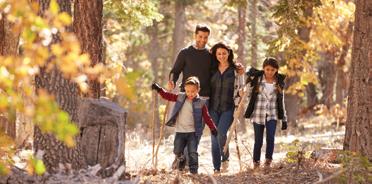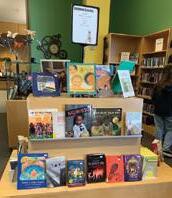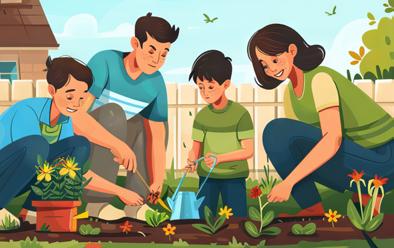SURPRISING REASONS
PREVENTING Your Kids from Becoming STRESSED to Give Your Child Chores

Communicating with YOUNG ADULT CHILDREN
Family TRADITIONS



SURPRISING REASONS
PREVENTING Your Kids from Becoming STRESSED to Give Your Child Chores

Communicating with YOUNG ADULT CHILDREN


Matthew S. Vorell, PhD wrote Family Traditions: The Heartbeat of Minnesota Families on page 4.
Jill Morgenstern wrote Ten Surprising Reasons to Give Your Child Chores on page 6.
Emily Goenner Munson wrote Communicating With Young Adult Children on page 8.
Brandy Browne wrote The Do’s and Don’ts of Being a Good Friend to Someone Struggling With Mental Health on page 12.
Tanni Haas, Ph.D. wrote How To Prevent Your Kids From Becoming Stressed on page 14.
Kristy Flowers wrote Therapeutic Gardening Your Nature-Powered Escape on page 18.
Know More about the writers at: MinnesotaFamilyMagazine.com/writers 04 06 08 12 14 18

Copyright © 2024 Minnesota Family. Content in contributed articles, and content in advertisements, is not verified by Minnesota Family. Minnesota Family will consider submissions from writers with a good message on their heart. Minnesota Family reserves the right to select articles for each edition based on fit, and values diversity. Minnesota Family offers advertising space, advertisers submit print ready ads to Minnesota Family. Arrangement, information, and format protected by copyright laws. No information may be reproduced in any form without written consent of the publisher. Minnesota Family and its members assume no liability for errors or omissions. Information is provided directly by the corresponding agencies. It is considered “self-reported data” and is not verified by the publisher. Contact Minnesota Family | Advertising: Info@MinnesotaFamilyMagazine.com | Editorial: Editors@MinnesotaFamilyMagazine.com




In the heartland of Minnesota, family traditions are the interwoven threads binding the tapestry of our shared experiences, cherished memories, and rich cultural identities. They form an unbreakable cord connecting us to our storied past, anchoring us in the present, and guiding us toward the future. These traditions create an enduring legacy of warmth, deep connection, and profound belonging that resonates across generations.
As a child growing up in Cleveland, Ohio, one of my most treasured rituals was getting pizza every Friday night with my family from our beloved local pizzeria, Gepetto's. The frenzied stresses of the week melted away as we gathered at the kitchen table, indulging slice after slice. A simple family meal, yet it cultivated an indescribable sense of security, unconditional warmth, and unbreakable ties that still resonate today.
Such cherished traditions bond Minnesota families across geography and generations. They foster a shared identity rooted in heritage, enabling us to embrace our ancestral origins and the sacrifices of ancestors. For many, grandma's recipes for pulla bread, rosettes, and krumkake became staples of family get togethers, tangibly connecting us to our Scandinavian roots each holiday season.
The significance of family traditions, however, extends far beyond creating memories. They foster an intrinsic "us versus the world" unity vital to preserving family kinship and psychological wellbeing. No matter how scattered our lives became, traditions
By Matthew S. Vorell, PhD
served as immutable reunions anticipated with certainty –standing invitations to reconnect and revel in the comforting familiarity of those who knew us intimately.
Psychologists emphasize the immense value of shared rituals and oral histories for promoting profound closeness, bolstering wellbeing, and instilling steadfast identity in children and adults. Traditions provide invaluable stability and constancy amidst life's inherent chaos. They gift us true predictability, security, and chances to nurture positive emotional connections within the family. Among their greatest strengths is allowing families to carefully craft rituals aligned with their values, cultural lineage, interests, and the intricate personalities and humor that make each clan unique.
These timeless traditions become the framework for creating enduring positive memories and cultivating an unshakable sense of belonging within Minnesota families. Sustained and passed down with reverence and nostalgia, these moments become the foundation of the memories future generations will draw upon – sacrosanct emblems of heritage and identity, representing the experiences that defined our upbringing. For my family, it was those grease-stained, boisterous nights sinking our teeth into Gepetto's cheesy pizzas that made me feel inseparably connected to my mother, father, and sister.
The beauty of Minnesota's family traditions lies in their infinite forms, each carefully customized to the specific interests, shared struggles, and quirky inside jokes unique to every clan.
Some bond over crafting batches of lutefisk and lefse from old recipes. Others meticulously build backyard ice rinks for pick-up hockey. Even weekly family game nights can transform into a cherished tradition.
Regardless of their unique origins, customs pass down ingrained beliefs, cultural legacies, senses of humor, and hard-earned ideals through repeated, formative shared experiences and stories. Most importantly, they fill our years' tapestries with vividly positive shared memories and private milestones that become the metaphorical glue binding families through joy and loss. When babies are born, we note resemblances; when elders pass, we tell stories commemorating their lives.
For my part, sustaining traditions requires no grand complexity – simple consistent gestures are often most profound. Even modest rituals like cooking a weekly favorite recipe, an annual Quarry Park hike, or reading 'Twas the Night Before Christmas' each Christmas Eve can blossom into beloved annual events. The key is making it a consistent, non-negotiable ritual that endures through chaos – ensuring every member is invested and involved, cultivating collective anticipation. Families shape



unique traditions around cultural heritage, interests, and humor defining their identity.
Adulthood granted me profound understanding of how indelibly childhood traditions shaped my personality, identity, and joy appreciation. As a parent, I uphold sacred traditions while cultivating new ones tailored to my children's distinct personalities, humor, and budding identities. Watching their eyes light up getting sushi at Hajime or turnovers from Backwards Bakery warms my soul as family tradition seeds take root. In our world of endless activities, simple traditions create an emotional anchor grounding us in comforting nostalgia and steadfast togetherness.
So let's cherish our Minnesota family traditions, these heartbeats sustaining us through thick and thin, summer sun, and whiteout blizzard. Let's honor rituals while creating new ones reflecting our unique experiences and humor. For these shared customs weave the beautiful, resilient, grease-stained tapestry of our family lives in this frozen tundra home. They are our Northstar, our lodestone – anchoring us to where we've come from and where we're headed as the next links in our storied chains.

is dedicated to supporting and inspiring healthy lifestyles through creativity, community, and connection to nature. Art in Motion builds unity and appreciation for Art and each other by hosting rotating gallery exhibits, weekly music performances, an open art studio, community events, a space friendly to families, folks of all ages, and users of the Lake Wobegon Trail— Boho Cafe nourishes this pursuit. The artist, the appreciator, and the traveling soul are all welcome here.



By Jill Morgenstern
My youngest daughter's help drags out the process of unloading the dishwasher. Not only is she slower than me, she is a reluctant participant. It takes longer for me to encourage her to start the task than it would for me to just do it myself.
When children resist it's tempting to just do the work ourselves. But having a child who takes out the trash or puts away laundry is more than just a convenience for parents. Teaching your children to do chores and encouraging them to complete them is time well spent.
Here are just some of the benefits children gain when they finally buckle down and get to work:
Believe it or not, children who have chores have been found to be more satisfied with life. According to a study in the Journal of Developmental and Behavioral Pediatrics in April of 2019, children who had done chores in kindergarten reported greater life satisfaction by third grade.
Knowing that a job needs to be done before watching TV or having a treat may help children learn delayed gratification, a form of self-control. A 2011 study from the University of Chicago demonstrated myriad benefits to increased self-control. Children with poor self-control were found to make more mistakes as adolescents. The children with poor self-control were also more likely to struggle financially in adulthood.
Being responsible around the house helps children learn the consequences of their actions. Did your daughter forget to clear her place after dinner? Her favorite plate might not be clean for
the following day. If, however, she remembered to put her clothes into the laundry instead of leaving them on the floor, she may find her T-ball uniform ready for the next game!
Whether they're trying to figure out the fastest way to clean their rooms, the best way to fold the bathroom towels so they'll fit in the cabinet, or how many dishes they can clear from the table per trip, children doing chores are constantly problem solving. These concrete situations can naturally help children build their problem solving skills.
5
Stories of kids going off to college unable to do their own laundry or make a meal independently abound. College is already a time of intense adjustment and change. Why force them to learn a whole new set of skills that they could have been introduced to early on? There are many parts of their own lives they'll have to manage for the first time. Giving them chores early in life means they'll be more prepared for operating on their own.
Whether it's a smaller child sorting socks or an older child trying to handle both broom and dustpan, chores can help children practice their motor skills. Large motor skills might be engaged while taking the garbage can to the curb or loading the washing machine. Activities such as dusting may encourage children to cross the midline. Crossing the midline is an important developmental skill that involves crossing arms or legs to the other side of the body and still operating them effectively.
Children who do chores will understand how their part helps the entire family. They get to see first-hand how their actions make life easier or more difficult for people they care about and vice versa.
Between school, extracurricular activities, and homework, chores tend to take the back burner. Having the responsibility for chores



can help teach children time management as they strike the balance between work and play.
There's some evidence to suggest that doing household chores builds empathy as children internalize helping and connecting with their family.
Children may resist doing chores quite vehemently but when push comes to shove, completing a chore gives them a source of pride. This may be particularly important when school work or sports causes their self-esteem to suffer.
Whether or not you need the household help, chores are well worth whatever effort you can manage. They are particularly beneficial in the early years as children's self-esteem and values are being formed. Making the investment when they are young not only provides benefits to your children, but eventually means that you will have extra help around the house as they grow older.



At school, I encounter students with strained family ties, those caring for relatives, and varying levels of family involvement. The most common struggle revolves around visit frequency and parental involvement in their lives. How involved in their lives should parents be?
As a parent of young adult children and a teacher of college students, I understand the challenges families face when transitioning from a parent-child to parent-young adult relationship. Parenting a young adult is challenging in a different way than when they were younger, but it is challenging, nonetheless.
As a parent, it’s difficult to know your role. How often do you call? When do you visit? What should you expect from a young adult child? You want them to become independent, explore their world, and plan their future. So, how do you find your way?
Having open conversations with your young adult children can help answer, or at least expose, many of the questions you have. This may be difficult, especially if you had challenging teen years, but discussing each person’s needs and expectations is important.
A conversation should start with a positive, supportive foundation and refrain from judgment. The more a child feels judged for their choices, the less they will interact and be open. Try to understand their views, instead of judging them. Usually, there is a point of agreement you can find somewhere.
Next, be honest and vulnerable. It’s hard to tell your kids you don’t have all the answers, but it’s important to show them you want to work with them, instead of controlling them. I’ve told my kids I
By Emily Goenner Munson
don’t know exactly what I should do now, and they chuckle. I’ve said, “what do you need or want from me?” I usually get an, “I don’t know,” but the question itself reveals my uncertainty and shows respect and concern for the child’s growing self. I’ve told my kids, “I’m here when you need me, but I don’t want to crowd you. I’ll do my best to respect your needs. Just tell me.”
When they do talk, listen to, and help identify, their needs. I’ve found my kids and college students often don’t know what their needs are, so, like when my kids were young, I lay out some options. Do you want your parents to call, or do you want to call? Do you prefer texting? How often is reasonable? What topics are ok to ask about and which do you prefer to share when you’re ready? Trying to care and know about your young adult, while giving them space and privacy, can be an awkward and sometimes painful space. So, having a conversation about each person’s hopes and expectations may help smooth that discomfort, and remember even if it feels like rejection, you’re giving your child space to grow.
“I’m here when you need me, but I don’t want to crowd you. I’ll do my best to respect your needs. Just tell me.”
Finally, balance inclusion and obligation. Young adults still need to be active members of the family, but, as parents, we may have to release some of our expectations so they can explore their lives. Our family has many gatherings, so I’ve said, “I’ll tell you when I really want you to be there. The rest of the time, I want to include you, want you there, but know you have your own lives. If you can come, great, if not, that’s fine.” I want the kids to know they are wanted, but also want them to have freedom to say no. Hopefully, this keeps them involved in the family but not too pressured to attend every family function.
Parenting young adult children can be difficult, but open communication will help foster a new, more mature relationship with your child built on mutual understanding, respect, and trust. Approach conversations with empathy, listen to their needs, and be willing to adapt your role as they grow into independent adults. While the dynamics may shift, the bond you've built remains strong, and this new chapter can be a rewarding one for both you and your child.








The Irelands live near Saint Cloud, Minnesota. Kaelin and Paul have been married for 17 years. They have nine children from 15 to 2 years old. They are regularly asked, “are they all yours?” They say “yes, we have nine biological children together”. The Irelands share that having a large family is a lot of fun! There’s always something going on, always someone to talk to, and always someone to play with. Paul shares, “Having a large family is purposeful and meaningful work, because our kids are eternal beings. We love all these people!” The Irelands homeschool their children. Kaelin has been a stay-at-home mom since their first child was born. Paul works from home building enterprise web applications. They share that most days they are all at home and are often together.
Q: Did you always know you wanted to have 9 children?
Kaelin: While we were dating, I asked Paul how many kids he would like to have. To my surprise, he said five! I thought that was really cute, it demonstrated his big heart.
Paul: At that time of my life saying five kids was like saying a dozen! Neither of us come from a large family. I have one brother and Kaelin has two younger half brothers. We both liked the idea of our kids having a lot of siblings.
Q: What are your kids into?
Paul: As a family we focus on creating, being active, and being outside. This is in contrast to consuming and being sedentary indoors. Our kids enjoy soccer, gaga ball, ultimate frisbee, biking, roller blading, longboarding, swimming, hiking, tag, and having adventures outside. Inside they like to read, listen to audio books, draw, make art, play board games, bake, build forts, and play all kinds of imaginative games.
Kaelin: While watching TV one day in college, God spoke to me and said “stop watching other people and live a life worth watching.” We want the same for our kids!
Q:Best advice you’ve received?
Kaelin: I’ve received so much good advice. One of the funniest tips I received from a mom of five, which is actually really good for us still, is “EVERYONE takes a nap!” We have quiet time every day in the afternoon where many of us nap and other people read books or play games quietly.
A good friend and mom of eight once told me, “a wise woman always accepts food.” It's true, whenever we have a big gathering and people offer to bring food I always say “Yes, thank you!”
Q: What are some of your family's best practices?
Kaelin: Reading together. Reading to our kids has blessed us as parents and our kids immensely. We have learned so much together and our children now enjoy reading and learning.
Eating together. We always have dinner together. It is required for all family members. We have many good discussions around our dinner table. Paul often reads books like “Farmer Boy” or the Bible aloud to the family. We do “Kingdom Sightings”, voicing affirmations for each child. Dinnertime is not always perfect and often some little person is yelling, someone is talking potty talk, or someone is stabbing the table with a fork, but we are determined to keep it going.
Working together. Whenever there is a big project to be done, getting everyone on board takes the stress off and makes everything go more smoothly. Something we say in our house often is “many hands make light work!”
Paul: We prefer activities we can do together. Togetherness is an intentional practice.
Q: Favorite moment as a parent so far?
Kaelin: My every day is filled with many beautiful moments! I really enjoy our kids! I have so much fun watching the baby waddles and hearing baby talk, listening to our elementary aged kids recite long scripture verses from memory, and talking to the teenagers about hair and clothes and relationships and all that teenager stuff. A highlight moment from this last year was watching our kids take the top positions in their league in the Minnesota state JBQ competition.
Paul: A memory I treasure is when I called over one of our little boys while on the stairs. He ran over and with complete abandon jumped down the stairs toward me. I wasn’t expecting it but my dad-reflexes pulled through and I caught him! I was touched by his total trust in me!
Read the full interview including how Paul and Kaelin met, funniest kid stories, and more at: MinnesotaFamilyMagazine.com






By Brandy Browne
We all have mental health. And an estimated 1 in 4 of us will struggle with our mental health at some point in our lives.
In the United States alone, an estimated 1 in 5 adults experiences either depression or anxiety every year. In the United Kingdom, an estimated 1 in 6 adults will experience a common mental health problem in any given week.
We know that people are struggling, but what if it’s someone we know? What if it’s one of our closest relatives or friends? How can we be there to support them?
Instead of panicking or ignoring the problem, let’s take a look at some practical ways to support our loved ones with their mental health in their time of need.
DO listen and validate their feelings: If you want to encourage your loved one to keep talking, focus on asking questions that require more than a simple “yes” or “no” answer. Even if you do not necessarily understand what your loved one is going through, responding with a simple “that sounds really difficult” can be very comforting.
DO ask how you can help: This is not the time to make assumptions. What someone else needs is not necessarily what you need. For example, I am a “words of affirmation” and “acts of service” type of person. The way to my heart is telling me that I’m doing a good job, that you see me and value me, or possibly helping out with a task. However, this may not be what others need when they are struggling.
DO make sure to celebrate the small wins: Maybe just going to work is difficult. If you see your loved one in a new outfit or trying out a new hairstyle, compliment them. If doing anything in the evenings after work has been super hard for them, but you notice they took the dog for a walk, celebrate it! Every win matters when your loved one is battling depression or other mental health issues.
DO read up on what your loved one is struggling with: There is a wealth of knowledge on all things mental health, and it’s available free of charge online. When seeking information, always make sure that it is written by professionals and published by accredited organizations.
DO check in regularly, normalize talking about mental health, and recognize that not everyone’s struggle looks the same: What my depression looks like (staying exhausted, losing interest in things that once brought me joy, feeling like I was moving all the time but making no progress, etc.) looks very different than what my husband experiences with depression. He tends to be more irritable, not sad.
By keeping the conversation open with your loved one, you’ll be able to stay in tune with how they are feeling. You’ll also have a better feel for how to support them.
DON’T compare your experience to theirs or engage in “toxic positivity”: Your loved one does not need a contest over who has been through “worse.” Keep the focus on their experience, and avoid phrases like “you shouldn’t be feeling sad, you have so much to be grateful for.”
DON’T use stigmatizing language: Telling your friend or loved one that he or she is “crazy” or being “overly dramatic” simply perpetuates the stigma that mental health issues are something to be ashamed of.
DON’T take it personally: I like to use the handy acronym “Q-TIP” which stands for “Quit Taking It Personally”. Avoid being confrontational and recognize that your loved one’s behaviors are in response to what they are going through.
DON’T be easily discouraged: It’s like when you first start being intentional about healthy habits…at first, you can’t see the difference that swapping the cookie for an apple or working out thirty to forty-five minutes a day is doing for you. However, with time and consistency, you get visible results. Initially, it may seem like you aren’t able to do much for your friend or loved one. However, by maintaining your support over time, your loved one will likely improve.










By Tanni Haas, Ph.D.
While low levels of stress are normal, stress can be damaging to your kids’ physical, mental, and emotional health if it comes in high doses and persists over time. If that’s the case, what can you do to prevent your kids from becoming overwhelmed by high levels of stress? Experts agree on the following points:
It might sound counter-intuitive, but the first and most important thing is to take good care of yourself and try not to get stressed. ”Stress is really contagious,” says Lynn Lyons, a child and adolescent psychotherapist and author of Anxious Kids, Anxious Parents. “When parents are stressed out, kids are stressed out.” Try to stay calm at all times and model stress-free behaviors to your kids. “Just like flight attendants advise adult passengers to put on their own oxygen masks before assisting others,” says Dr. Jamie Howard, a clinical child psychologist, “parents need to attend to their own physical and emotional needs to be able to best support their children.” This means that you should avoid being tired or hungry for prolonged periods of time, and that you should seek emotional support from other adults when needed. “If you take care of yourself and schedule time for your own needs,” says Dr. Amy Przeworski, a professor of child psychology, “your child will learn that self-care is an important part of life. Children learn behaviors from watching their parents. So when you think about your child’s psychological well-being think about your own as well.”
Educate your kids about stress – what it is and how to recognize it. Mrs. Lyons says it’s important that you teach your kids “to understand their own bodies and the physiology of stress.” Specifically, kids need to learn to tell the difference between normal and stressed reactions to what’s happening to them. “While it’s normal for a child’s stomach to feel jumpy on the first day of school,” says Mrs. Lyons, “leaving class because their stomach hurts or waking up repeatedly with a headache is a sign there’s too much going on.” Katie Hurley, a child and adolescent psychotherapist and author of The Happy Kids Handbook, agrees: “To help your child connect the dots, draw the outline of a body and pinpoint different places where stress can cause problems.” Explain to your kids all the common physical symptoms of stress, including backaches, headaches, neck aches, and stomachaches, and help them see where and how they react when they are stressed. As Mrs. Hurley puts it, “the more kids understand the connection between symptoms and stress, the better able they will be to seek help.”
Besides teaching your kids how to recognize stress, also try to make them more resilient towards it. One useful technique is to teach your kids to take a couple of deep breaths when they are in a stressful situation. “Taking deep breaths can actually have a physiological effect on the body,” says Janice Halloran, a licensed mental health counselor and author of The Coping Skills for Kids Workbook. “When you’re stressed, your body goes into fight, flight or freeze mode and your breathing automatically gets more shallow. To trick your body into getting back to a more restful state, take deep breaths.” It’s also useful to practice relaxation techniques with your kids. Dr. Przeworski recommends teaching your kids to imagine themselves somewhere relaxing, like the beach or in a backyard hammock, and then imagining all “the sounds, smells, and sensations associated with the image.” You can help make your kids more stress-resilient by encouraging them to confront their fears head on instead of shying away from them. Amy Morin, a licensed psychotherapist and author of 13 Things Mentally Strong Parents Don’t Do, makes this important point with the example of elevators. If your kid is afraid of elevators and you always suggest taking the stairs instead, you are essentially teaching your kid that s/he must be too fragile to take the elevator: “They grow up thinking, ‘I’m not a capable person. If I’m afraid of something, I shouldn’t do it. My parents don’t believe in me, why should I believe in myself’”? Once again, kids model what their parents do. “If children are surrounded by adults who model resilience,” says Dr. Lyn O’Grady, a child psychologist, “through their own behaviours as well as by explicitly teaching and practicing the social and emotional skills, they will be more likely to develop resilience themselves.”
Finally, cultivate stress-free activities for your kids to do whenever they feel like they are about to get stressed. Mrs. Hurley suggests that parents create “stress-free zones” or “relaxation centers” in the home where kids can engage in their favorite activities. Similarly, Mrs. Lyons recommends that parents encourage their kids to engage in activities that are characterized by “pure play” - with no winners or losers, no particular end goal, and therefore no pressure to perform or reason to get stressed, such as outdoor sports like bike riding, hiking, and running.

Discover sustainable soil blends that nurture your garden naturally. Scan the QR code to locate our products at a nearby store and start your garden journey today.



























In our fast-paced and digitally connected world, finding moments of tranquility and connection with nature has become increasingly crucial for our mental and emotional well-being. One activity that has gained significant attention for its therapeutic benefits is gardening. Beyond just a hobby or a means of growing plants, gardening has the remarkable ability to teach us patience, engage our senses, and provide valuable lessons in both success and failure. It is a transformative journey that nourishes your mind, body, and spirit.
In an era of instant gratification, gardening reminds us of the beauty and rewards that come from patiently tending to something over time. From sowing seeds to nurturing their growth, gardening demands a level of patience that allows us to appreciate the gradual development process. As we wait for seeds to sprout and plants to bear fruit, we learn to embrace the journey rather than merely fixate on the end result. This practice of patience in gardening can translate into other areas of our lives, teaching us the importance of perseverance in the face of challenges.
Gardening is a multisensory experience that engages all our senses, grounding us in the present moment. The sweet fragrance of blooming flowers, the texture of rich fertile earth running through our fingers, the vibrant colors of plants, the rustles of leaves in a breeze – all these sensory inputs stimulate our brain and evoke a sense of calm and connectedness. Scientific research has shown that exposure to nature and natural elements can reduce stress, lower blood pressure, and improve overall well-being. By immersing ourselves in the sensory richness of gardening, we can create a sanctuary of tranquility in our backyards.
Here in the Land of 10,000 Lakes, surrounded by stunning natural landscapes, gardening becomes an extension of that connection. As you nurture your plants, you're nurturing a piece of Minnesota's vibrant ecosystem. And as the sun drops below the horizon, transform your garden into a nocturnal haven. String up twinkling lights to create a warm ambiance; if you're lucky, you might even witness the delicate dance of the northern lights, painting the night sky with vibrant hues. Keep an eye out for the gentle flicker of fireflies, adding their magic touch to the scene.

Gardening is an ongoing learning process involving both triumphs and disappointments. Despite our best efforts, plants may wither, diseases may strike, or unexpected weather events can disrupt our plans. However, these setbacks provide valuable opportunities for personal growth and resilience. Gardening struggles teach us to adapt, problemsolve, and bounce back from failures. On the flip side, experiencing success in gardening – whether it's nurturing a vibrant flowerbed or harvesting your vegetable crop – instills a sense of accomplishment and pride. This cycle of failure and success in gardening reinforces the importance of perseverance, teaches us humility and resilience, and reminds us to celebrate the small victories along the way.
Gardening is much more than a simple hobby; it is a transformative journey that offers therapeutic benefits for our mind, body, and spirit. As we cultivate patience, engage our senses, and navigate the highs and lows of success and failure, gardening becomes a powerful tool for personal growth and well-being. Whether you have a sprawling garden or a few potted plants on a windowsill, embracing the joys of gardening can bring us closer to nature, ground us in the present moment, and remind us of the beauty and resilience of life itself.
Get your family involved in the gardening process. It's a fantastic way to spend quality time together, teach children valuable life lessons, and create lasting memories. Plus, you can share your harvest with friends and neighbors, fostering a sense of community spirit. So, grab your family, head outside, and get ready to watch your garden – and your hearts – flourish!
Tips For Getting Started with Therapeutic Gardening
Start Small:
If you're new to gardening, begin with a small project, such as planting a few pots of herbs on your windowsill.
Choose Easy-care Plants: This will help you to avoid feeling overwhelmed and frustrated.
Find your Favorite Spot:
Select a spot in your yard or home that you enjoy spending time in. This will make gardening more enjoyable and therapeutic.
Be Patient:
Gardening takes time and patience. Don't get discouraged if things don't go your way right away.
Have Fun:
Gardening is supposed to be enjoyable. So, relax, take your time, and enjoy the process.


